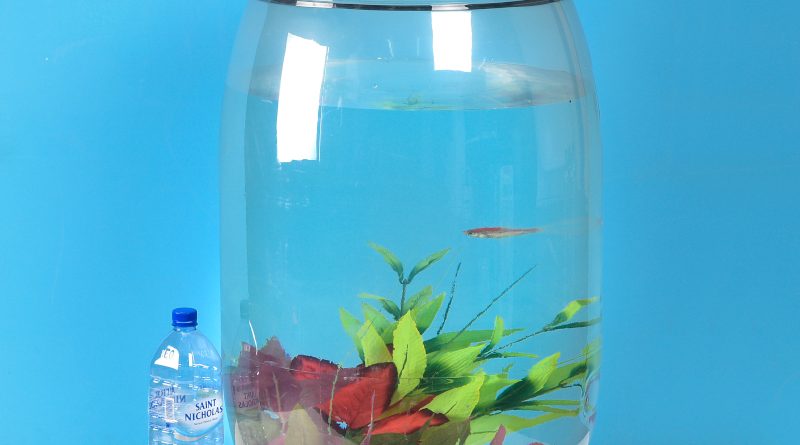World’s biggest PET container
Cypet, Hall 14, Booth C58
120 l open-mouth PET drum with 400 mm neck diameter
Drums are used for the storage and transport of a wide variety of products. Traditionally metal has been the material of choice, however plastic drums made from HDPE have become very popular as well as fibre drums to a lesser extent. Sizes vary from 30-220 l and various types are available according to the size of opening (open top, wide mouth, closed top). The tendency of metal drums to rust and the sensitivity of fibre drums to wet conditions, have resulted in the popularity of HDPE plastic drums, manufactured using Extrusion Blow Moulding. By using PET, Cypet are now adding another new material into the mix.
The only other plastic raw material besides HDPE that exhibits high mechanical strength and is suitable for processing into hollow containers is PET. In addition to its very good mechanical properties, PET also offers transparency and a smooth, glossy surface finish, making PET containers easy to clean. It is also easily recyclable and can be upgraded during the recycling process to bring its properties back to their original levels, including the suitability for food contact applications after recycling. PET containers have very successfully replaced other materials such as metal, other plastics, glass and paper in many applications typically in sizes up to 2 l, but more recently also for applications in the 5-30 l size range.
PET processing technology for large containers
Machines for PET processing have been commercially available for the production of PET containers up to a maximum size of 30 l. As a result of the non-availability of machines for PET containers larger than 30 l, this market segment had not been developed for PET, despite the fact that large PET containers offer a cost efficient and attractive alternative to other materials for large containers.
Cypet Technologies states that its single-stage PET processing technology has been proven to be able to produce very large PET containers, up to 150 l. The Cypet production system has the capability to injection mould the preforms and directly stretch-blow mould them into containers on the same machine, in such a way that enables large container production with minimal energy consumption.
In Cypet’s history of success, the world’s first 50 l PET container, a beer keg, was produced in Australia in 2015 on a Cypet machine. The world’s second 50 l PET container, a milk drum with built-in rigid handles, was produced in 2016 in Kenya, also on a Cypet machine. In 2018, finally breaking the 50 l size barrier, Cypet Technologies’ engineering team, succeeded in producing a 60 l PET container, the world’s first transparent, stackable crate for fruit and vegetables, with a large, rectangular 570 x 370 mm neck opening.
PET drums become reality
In 2019, the Cypriot company broke its own record in large PET containers, by producing an open-mouth PET drum of 120 l, with a 400 mm neck diameter, providing the PET processing industry with the opportunity to enter new applications, with a unique and value-adding PET container.
The main advantage of PET drums is their lower weight, typically being about one-third less than for an equivalent HDPE drum. This is made possible by the superior mechanical properties of PET and generates substantial savings in raw material cost. The resulting important economic, logistical and environmental bene-fits, especially for export-oriented applications, makes the shift to PET drums an attractive option.
In addition to the weight reduction, PET drums can be made transparent, which may be preferable for specific applications. Furthermore, due to the orientation of the PET molecules during the stretch blow moulding process, PET drums provide very good barrier properties for alcohol and essential oils products. Finally, the smooth, glossy surface finish provides an attractive appearance and also allows for easy cleaning when required.
Tailored drum dimensions for export
Many products are exported in drums, like active pharmaceutical ingredients, pigments, fish oil, chemicals etc., for which logistics efficiency is very important. Drum dimensions can be optimised to container loading, saving freight costs. For example, a 100 l PET drum specially-designed by Cypet for the bulk drug industry, fits nine drums per pallet, allowing the loading of 360 drums per 40 ft container. This compares to five HDPE drums per pallet currently used, resulting in an increase of container loading from 200 to 360 drums, representing a 44% reduction in shipping costs.
There is additionally a significant saving to be made on the drum cost, which would have a weight of about 1.8 kg, compared to 2.4 kg for HDPE. This is a saving of 25% on raw materials in addition to a saving on electricity due to the Cypet machine’s low energy consumption.
An additional benefit of PET drums for all applications, including for exports to environmentally sensitive countries, is the fact that the PET drums are easily recyclable repeatedly at the end of their service life and re-used in various applications, thus completely closing the loop and enabling a fully circular PET economy.

